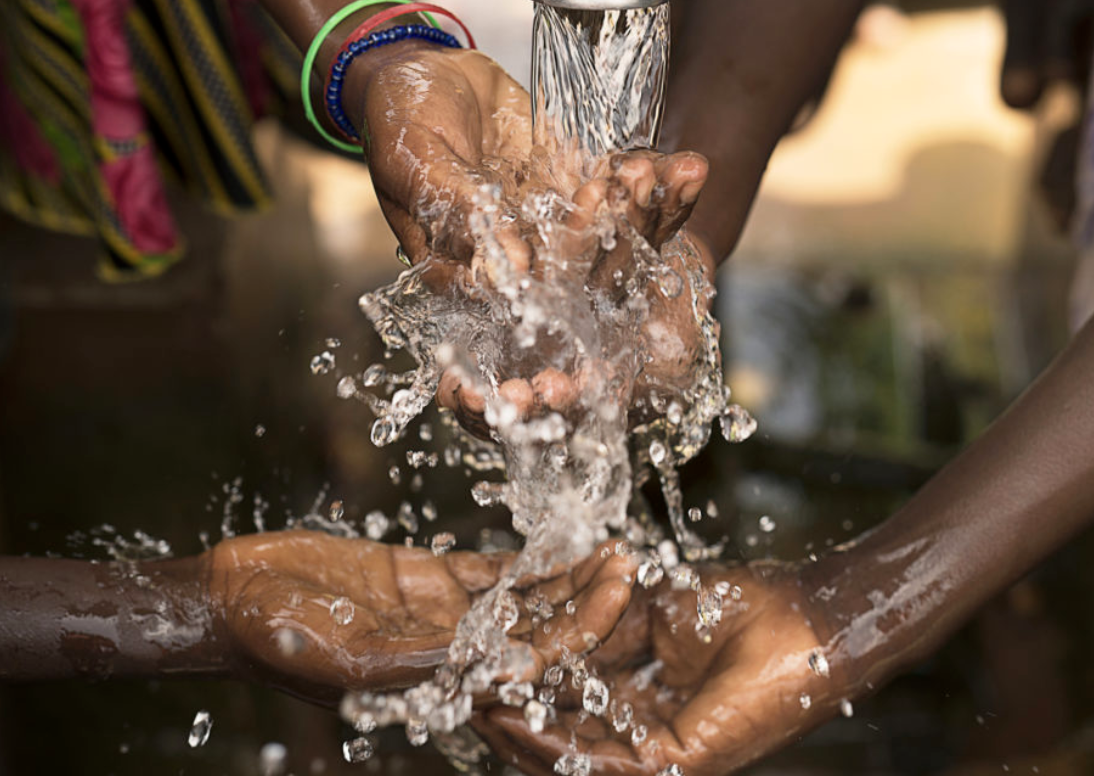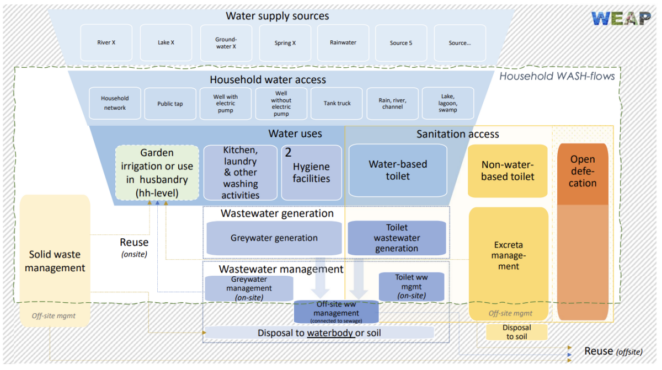WASH Flows Tool

This tool is part of theSEIUrban Toolbox for Liveable Citieswhichhas been developed by theSEI Initiative on City Health and Wellbeing.The Urban Toolbox isa collection of tools, developed within SEI or in coordination with SEI,aimed at supporting planning and decision-making for improving the health, well-being and resilience of city residents and urban systems more broadly.
GO TO THE SEI URBAN TOOLBOX FOR LIVEABLE CITIES HOMEPAGE
About this tool
WASH Flows is a new tool developed by the SEI Bolivia WATCH team. Using a Microsoft Excel interface it comprehensively represents the simplified conditions of water, sanitation and hygiene (WASH) services at the community level through quantitative analysis and graphical representations. WASH Flows includes functionalities that can either be used on its own, or applied in connection to a watershed scale modelling tool. This connects two water security disciplines (WASH and Integrated Water Resource Management) that have been traditionally disconnected from the technical and governance perspectives.
*This Urban Toolbox article is an abridged version of the original text, which can be downloaded from the right-hand column. Please access the original text for more detail, research purposes, full references, or to quote text. Please also note that currently,WASH Flows is under a beta version and is being tested as part of the Bolivia WATCH project to finalize a generic version of the tool that can be adapted to other regions.
How does this tool work?
The WASH Flows tool inputs data on water source, water, sanitation and hygiene infrastructure and final disposal of wastewater at the household level into a Microsoft Excel spreadsheet. This data can be collected via household surveys and secondary sources. Formulas and inferences established in the Microsoft Excel spreadsheets estimates the quality of WASH services at the community level and calculates the water demand and return flows at the household level.
The tool was designed following the framework built by the Joint Monitoring Program (JMP) for Water Supply, Sanitation and Hygiene, developed by UNICEF and WHO, which estimates WASH service levels (i.e. access) through a series of specific indicators and from information collected at the household level (Cotton & Bartram, 2008).The WASH service levels are used to monitor global progress on Sustainable Development Goal (SDG) 6.
Who might use this tool?
WASH Flows is designed to be used by local water and sanitation utilities and decision makers at different levels (i.e. government environmental organizations), practitioners, social scientists and development agencies. It can be used to identify vulnerable communities and prioritise WASH interventions, and also to evaluate the quality of current WASH infrastructures and monitor progress towards SDG 6 targets.
Which stakeholders are involved?
Local communities are required to access household WASH data; researchers; WASH service providers; urban planners and policymakers; local stakeholders (e.g. WASH companies).
What stage of the process does this tool support?
- Generating knowledge and ideas
- Identifying problem areas and solutions
- Monitoring and evaluation
Tool overview
Context:
Achieving sustainable water, sanitation and hygiene (WASH) services requires an understanding that water comes from a hydrological system and, likewise, an inadequate sanitation system implies degradation of the system’s water quality. This simple connection highlights the importance of integrating the WASH framework with the Integrated Water Resource Management (IWRM) framework, which is practiced by most Latin American countries to achieve water security and support water governance.
The Stockholm Environment Institute (SEI) conceptualized and implemented an innovative analytical tool named WASH Flows in the context of the Bolivia WATCH project, funded by the Swedish International Development Cooperation Agency (Sida). It can be applied to both rural communities and urban settlements.
Modelling the interlinkage of WASH and IWRM:
The WASH Flows tool can be used:
- On its own, to estimate WASH service levels, water demand and wastewater generation based on current households’ infrastructure. The tool can compare how different WASH interventions influence the service level and can help prioritize vulnerable communities where WASH interventions should be implemented. Additionally, it can estimate contamination loads resulting from inadequate or inexistent sanitation systems.
- Coupled with a watershed modelling scale tool, to solve the problem of connecting data at the household level and the basin level. As shown in Figure 1, the basin model encompasses all existing water supplies, including household drinking water access, within WASH Flows. This interaction allows users to analyse the reliability of the current or proposed water supply sources and their potential impacts on a basin’s water availability.
- To analyse the sanitation and wastewater produced at the household level, estimating the quantity and quality of disposed water. When this quantification is integrated into the basin model, users can analyse these actions’ potential effects on downstream water uses and propose alternative wastewater management strategies.

The ultimate vision of WASH Flows is that it will be able to support water security analyses including:
- Assessing the current state of WASH services coverage in comparison with national goals for drinking water, sanitation and hygiene coverage
- Estimating contamination loads in the environment resulting from inadequate sanitation at the household or community level
- Prioritizing interventions in water, sanitation and hygiene by comparing the WASH service levels of different communities through a vulnerability analysis and identifying communities in which WASH interventions should be implemented.
- Anticipating the benefits and impacts of WASH development interventions and comparing the effectiveness of various WASH interventions
Application: WASH Flows case study examples
Using the WASH Flows tool in the in the development of the Tupiza watershed plan, Bolivia: this case study demonstrates how the tool can be used to identify deficiencies in WASH services, and also to explore the potential impacts of proposed WASH actions on communities in the watershed.
Capabilities and resources required
Capabilities and resources required to use the WASH Flows tool include:
- Knowledge of WASH and water resources management.
- Skills in and access to Microsoft Excel and supporting technology to input the data.
- Trained people to conduct household surveys and access the WASH data.
Implementation tips: key enablers and potential barriers
Below are some reflections and tips on how to use the tool effectively in practice:
- Clearly communicate the purpose of data collection to local stakeholders.
- Obtain endorsement from local community authorities or leaders to collect local WASH household data.
- Pilot the household surveys to ensure that the tool is adapted to the local context.
Some potential barriers include:
- Limited WASH data available at the community level for validation.
- For the connection with watershed modelling: limited hydrologic data about other water sources than main rivers in the watershed (e.g., springs, groundwater)
Potential integration with other tools
WASH Flows can be used in combination with a watershed scale modelling tool, such Water Evaluation And Planning – WEAP.
Suggested Citation:
Claure, P., Esquivel, N. N., Liera, C., Soto Trujillo, A., & Escobar, M. (2023).Introducing the WASH Flows analytical tool: Integrating sanitation and watershed management for improved water governance and investments. Stockholm Environment Institute. https://doi.org/10.51414/sei2023.009
Related resources
- Using WASH Flows in the in the development of the Tupiza watershed plan, Bolivia
- Empowerment in WASH Index Tool
- Using EWI to inform the implementation of a WASH master plan in the municipality of Banfora, Burkina Faso
- Using EWI to strengthen gender dimensions in Asutifi North District WASH master plan, Ghana
- SDG Synergies Tool Primary tabs
- Water Evaluation and Planning (WEAP) Tool
(0) Comments
There is no content